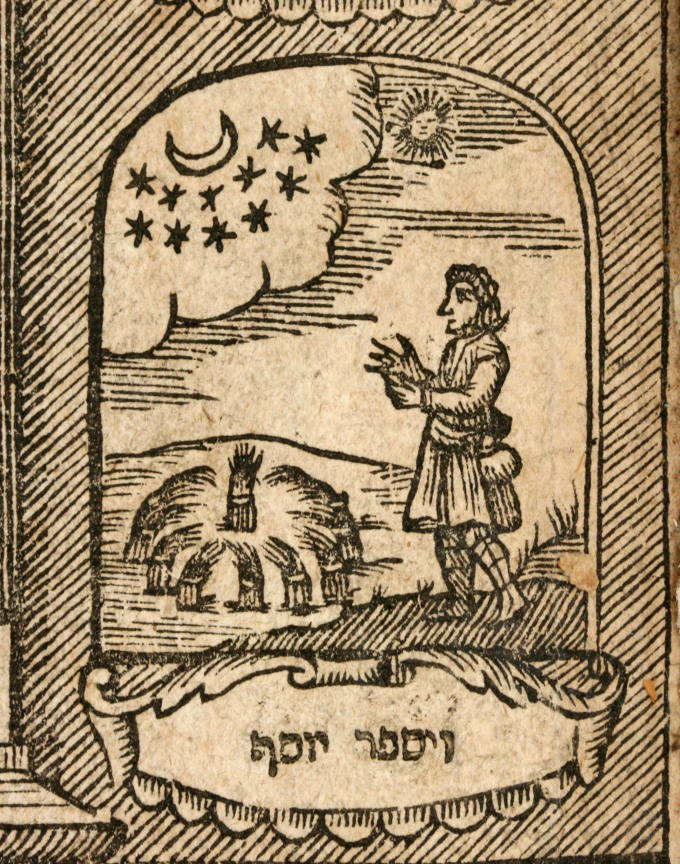Storytelling is so much of who we are, what we do and how we figure out how to live. But does every story need to be told? Maybe somethings are better kept to ourselves.
As I mentioned a few weeks ago, my friend William Gross has taught me much about how Jewish ritual objects and art tell stories. One particular form is micrography, an art form in which an image, or series of images, are made up of words, very often from biblical passages.
Micrography has been around for at least 1,000 years and with computer generated graphics is quite common today. But when viewing the older hand-made specimens you can’t help but be impressed by the careful effort that went into telling a story in this way.
The example below, a lithograph printed in Hamburg, Germany in 1899 was done by the artist Moshe Eliyahu Goldstein. It portrays Joseph being apprehended by his brothers who sell him as a slave to a passing band of merchants (Gen. 37):
Here is a closer look at this image in which you can make out the actual words from the Torah. For more about Jewish micrography, visit JTS Library’s online gallery.
The well-known tale of Joseph and his brothers, which appears in the beginning of this week’s Torah reading (Gen. 37), is not an easy tale to tell. Jacob makes a grave parental error by singling out his favorite son, Joseph – first-born of his beloved Rachel – for special treatment by giving him a unique garment. The jealous brothers plot to kill Joseph, throw him into a pit, instead sell him into slavery and eventually stage his death in order to explain his absence to their father.
But Joseph is no tzadik, or saint:
And Joseph brought bad reports of his brothers to their father. (Gen. 37:2)
And it seems that he was quite a storyteller:
Once Joseph had a dream which he told to his bothers; and they hated him even more. He said to them, “Hear this dream which I have dreamed: There we were binding sheaves in the field, when suddenly my sheaf stood up and remained upright; then your sheaves gathered around and bowed low to my sheaf.” His brothers answered, “Do you mean to reign over us? Do you mean to rule over us?” And they hated him even more for his talk about his dreams. (vss.5-8)
Even before this incident, we are told that Jacob’s special love of Joseph caused his brothers to hate him (vs.4). That hate is now intensified by Joseph telling the story of his first dream, and then a second:
He dreamed another dream and told it to his brothers, saying. “Look, I have had another dream: And this time, the sun, the moon, and eleven stars were bowing down to me.” And when he told it to his father and brothers, his father berated him. “What,” he said to him, “is this dream you have dreamed? Are we to come, I and your mother and your brothers, and bow low to you to the ground?” So his brothers were wrought up at him, and his father kept the matter in mind. (vs.9-11)
Perhaps it wasn’t entirely his fault (though Freud would say otherwise) that those particular visions filled his dreams, and in the context of the book of Genesis, this comes true, at least in part, when Joseph and the family are reunited toward the end of the book (chap. 42). But did Joseph really need to tell the others?
Below is a beautiful title page for a 1705 edition of Psalms from Amsterdam. Abraham, Jacob, Moses, David, Solomon and Jeremiah’s scribe, Baruch are featured here along side Joseph. It seems that these characters embody the contents of the book of Psalms. The first five of these are all quoted in the Hebrew Bible as praying, whereas Baruch and Joseph express words of prophecy regarding the future. Both of these are major themes in the Psalms.
Here is a closer look at the image of Joseph and his dreams:
Both dreams are shown in this engraving with the words vaysaper Yosef, “and Joseph told” inscribed below. Interestingly, this is not a direct quote from the Torah which says first vaysaper oto l’ehav, “and he told it (the dream) to his brothers”, and then, vaysaper el aviv, “and he told his father”. By restating the overall content of this story in just two words, yaysaper Yosef, the artist is emphasizing the storytelling aspect of this chapter. On one hand, it is presented here as something positive, linked to the contents of the book of Psalms. However, one can’t help but wonder if the hatred among brothers could have been avoided had Joseph kept at least some of what he knew, and felt, to himself.
Clothes play an important role in the Joseph stories. He received a special tunic from his father that was later dipped in blood so that Jacob would think he was killed by an animal. This leads Jacob express his grief by tearing his own clothes (37:31-35). Later on Joseph’s master’s wife will try to seduce him, holding on to his clothes. When he escapes, she is left with a piece of his garment in her hand, enabling her to accuse him of rape (39:10-18). Later, the brothers will not recognize Joseph, who as vizier to Pharaoh, presumably wore clothes very different from their own.
In Hebrew, the word for clothes is beged and the root of this noun, BG”D, is associated with deceit and dishonesty. The connection between the two is that our clothes cover up that what is underneath, not showing what is really there. I for one, am happy to be “dishonest” in this way
It is surely important in life that we strive to tell the truth and uncover deceit and injustice. But not all stories need be told.
Shabbat Shalom





